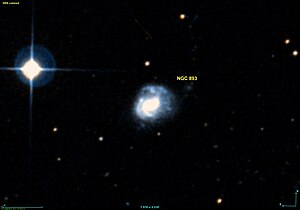NGC 893
| Galaxy NGC 893 |
|
|---|---|

|
|
| AladinLite | |
| Constellation | Phoenix |
|
Position equinox : J2000.0 , epoch : J2000.0 |
|
| Right ascension | 02 h 19 m 58.6 s |
| declination | -41 ° 24 ′ 11 ″ |
| Appearance | |
| Morphological type | SA (s) c |
| Brightness (visual) | 12.9 mag |
| Brightness (B-band) | 13.6 mag |
| Angular expansion | 1.3 ′ × 1.1 ′ |
| Position angle | 119 ° |
| Surface brightness | 13.1 mag / arcmin² |
| Physical data | |
| Redshift | 0.016846 +/- 0.000040 |
| Radial velocity | 5050 +/- 12 km / s |
|
Stroke distance v rad / H 0 |
(221 ± 16) x 10 6 ly (67.9 ± 4.8) Mpc |
| history | |
| discovery | John Herschel |
| Discovery date | October 23, 1835 |
| Catalog names | |
| NGC 893 • PGC 8888 • ESO 298-029 • MCG -07-05-017 • IRAS 02179-4137 • 2MASX J02195858-4124112 • SGC 021759-4138.0 • LDCE 164 NED003 | |
NGC 893 is a spiral galaxy of Hubble type Sc in the constellation Phoenix on southern sky . It is estimated to be 221 million light years away from the Milky Way and has a diameter of about 85,000 ly
. a. the galaxies NGC 889 and IC 1796 .
The object was discovered by John Herschel on October 23, 1835 .
